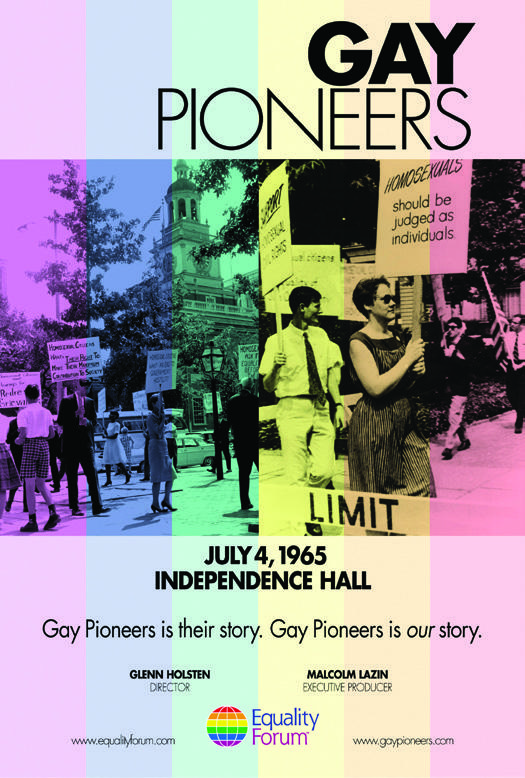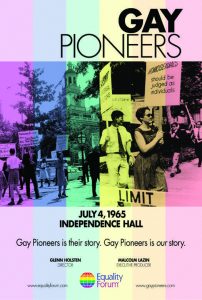Gay Pioneers

Gay Pioneers is the story of the first organized annual “homosexual” civil rights demonstrations held in Philadelphia, New York and Washington, DC from 1965-69. When few would publicly identify themselves as gay, these brave pioneers challenged pervasive homophobia.
On July 4, 1965, forty (40) people carried signs in front of Independence Hall supporting gay emancipation. Each year in NY, DC
That led to the then largest gathering for gays and lesbians when between two to five thousand people congregated in New York’s Central Park. The 1970 demonstration encouraged activists to stage the first gay pride parade in NYC. The New York Pride Parade was emulated in large and small cities in North America and worldwide and helped catapult an international civil rights movement.

Gay Pioneers is directed by PBS award-winning documentary filmmaker Glenn Holsten and produced by PBS affiliate WHYY and Equality Forum. It is about the gay and lesbian Rosa Parks. Gay Pioneers braids archival footage from these seminal demonstrations; FBI investigative files obtained under the Freedom of Information Act; gay pioneer interviews about the homophobia of that era, the protocol for the demonstrations and how those demonstrations impacted the movement and Barbara Gittings, Frank Kameny and Lilli Vincenz on-camera in 2004 discussing same-sex marriage.
Visit Website: http://www.gaypioneers.com
Purchase: http://www.equalityforum.com/store.cfm
LESSON PLAN – Tips for Teaching with Gay Pioneers
There are a variety of ways to use this film. Some ideas include:
- Showing it at a meeting of a student club (commonly known as a Gay-Straight Alliance, or GSA), and leading a discussion afterward (you can use some of the questions in this guide to help you do so).
- Donating it to your school library.
- Arranging an afternoon or evening showing, and inviting other student clubs from your school or other schools to join you.
- Giving it to your favorite history teacher and asking him or her to use it in their classroom.
- Approaching your administration to recommend it be shown in an assembly
No matter which road you choose, you might want to provide your audience with some background information to help them understand the documentary. Below are some terms that will help viewers unfamiliar with the subject, as well as some historical information that places it in a broader context. Read it aloud, transcribe it onto a blackboard, or copy it onto handouts.
Vocabulary
McCarthyism: Named for Senator Joseph McCarthy (R-Wisconsin), a period in the early 1950s when the government sought to expose Communists, LGBT people and other political dissidents (often identified as homosexual) from American public life.
Homophile Movement: The post-World War II political movement to increase understanding of gay men and lesbians and to combat social and legal persecution.
Mattachine Society: An early homophile group started in Los Angeles in the early 1950s, which had chapters in several U.S. cities by the early 1960s.
Annual Reminder: An annual picket march outside Independence Hall in Philadelphia 1965-69 to “remind” Americans that homosexuals were entitled to equal treatment like all other citizens.
Stonewall Rebellion: Three days of civil unrest in New York in June 1969, in response to a police raid on a gay bar called the Stonewall Inn.
Gay Pride March: Annual marches held in many cities each June since 1970 to commemorate the Stonewall Rebellion.
Discussion Questions
- What inspired these pioneers to protest
? What obstacles did they face? What things did they fear?- Where and when did they stage their protests? Why?
- How did they present themselves while protesting? Why? Did their style of presentation allow all LGBT people to participate?
- How did participating in the protests affect the way those who did so saw themselves?
- One of the narrators claims that these early protests set the stage for the Stonewall Riot in New York in June 1969, when three days of civil unrest occurred after LGBT patrons resisted police harassment during a raid on the Stonewall bar. How did it do so?
- How was the final “Annual Reminder” in Philadelphia in 1969 different from those that came before? Why?
- How did the nature of LGBT protests – known as Gay Pride Marches – change after 1969?
- What links are there between current controversies like gays in the military and gay marriage and the work of these Gay Pioneers?
A Historical Perspective
Gay Pioneers opens in 1964, at the first public protests advocating for “homosexual rights”. At the time, LGBT people were subject to arrest, commitment to psychiatric hospitals, and “medical treatments” intended to ‘cure’ them of their ‘disease’ that included electro-shock therapy, castration, and lobotomy.
Only a decade before, in the “McCarthy Era” of the early 1950s, gays and lesbians had been the subject of a furious political witch hunt. Gays and lesbians were thought to have a “weak moral fiber,” and were therefore considered to be a menace to the government. When Dwight Eisenhower became President 1953, he issued Executive Order 10450, which made homosexuality grounds for denying or dismissing persons from federal employment.
Despite this climate, emerging homophile groups like the Mattachine Society advocated for the equal treatment of gays and lesbians, but due to the threats they faced, tended to be conservative in their tactics. Rather than engaging in open confrontation, the goal was to work within the system to lobby for social acceptability! This strategy, though effective, tended to exclude people who didn’t fit the “norm” that the homophile movement wanted to emphasize—that is, LGBT people of color, low-income people, and those considered “gender deviants.”
The civil rights, black power, anti-war, and women’s movements of the mid- to late- 1960s, however, greatly inspired younger gays and lesbians to move to a more radical, militant stance. In the early morning hours of June 28, 1969, police officers raided the Stonewall Inn, a small bar located in New York City’s Greenwich Village. Police raids of bars where LGBT people gathered were common at the time, and the Stonewall was no exception. But this time, as the bar was cleared and arrests began, the patrons fought back. Hundreds of gay and lesbian neighborhood residents joined in the melee, which lasted for 2 hours.
The sense of anger that underscored the riots, the discovery of “strength in numbers”, and the realization that the LGBT community did not have to tolerate bullying and harassment at the hands of the authorities, quickly led to a more radical politicization. A new era had begun, one in which lesbian, gay, bisexual, and transgender people could demand to be accorded equal rights, and one which might not have happened were it not for the early activists who staged the protests documented in Gay Pioneers.
For more information, contact GLSEN at www.glsen.org

